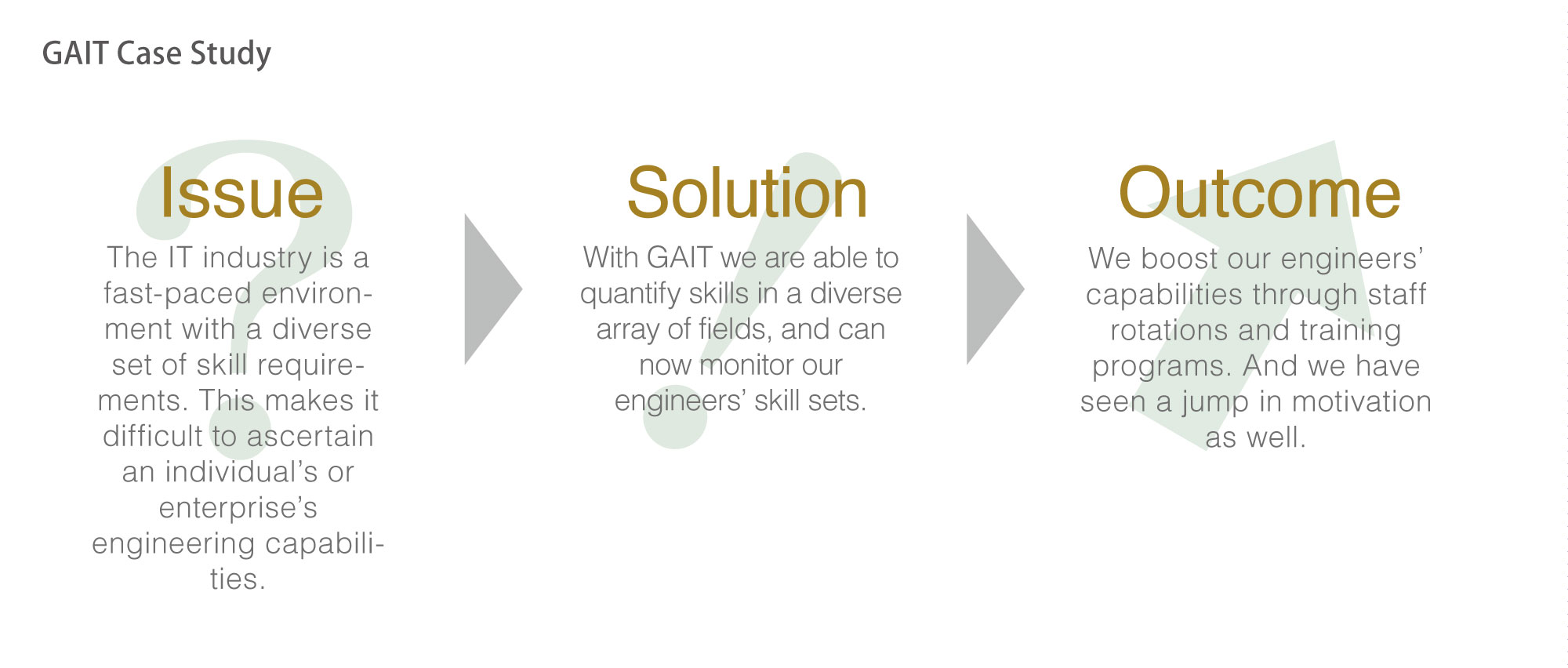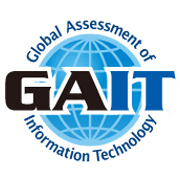ITOCHU Techno-Solutions Corporation
Making multi-skills “visible” in a numerical manner. Discovering of hidden capabilities becomes possible.
ITOCHU Techno-Solutions Corporation is a Japanese company providing IT solutions with added value to a wide range of customers. The company is using GAIT to assess the skill sets of engineers with the primary purpose of making skill sets visible. With all the engineers in the group taking the exam, a lot of new discoveries were made and future plans of utilizing GAIT to build a model of career paths were created.
For system integrators, the most important challenge for management strategy is to grasp the skill sets of your engineers. By knowing that, it makes it easier to decide to put who to what project, and show career paths for each person. Further more, it is also a perfect opportunity to objectively present your workforce and make an appeal of the excellence of your engineers externally. In order to meet this challenge CTC’s Enterprise Systems Group started using GAIT. The group provides IT solutions and support such as strategy to infrastructure, system development, maintenance and operation to a wide range of customers such as Internet-related companies, manufacturers, distributers, transportation companies, service companies and government agencies.

Mr. Eiichi Mizoi General Manager Enterprise Engineering Office Enterprise Technology Promotion Department

Mr. Haruyuki Yamazaki Section Chief Enterprise Strategic Planning Div. Human Resources Planning Division
In order to evaluate a broad variety of skills, being able to visualize the skills as a numeric value is necessary.
“The fast pace of business today, have led to diversification of required skill sets. ” says Mr. Eiichi Mizoi, General Manager of Enterprise Strategic Planning Div. The days of simple systems, where you were able to respond to customer requests with only the expertise of a certain products is over. In recent years, combining different products is common and a wide range of know-how is required. Specialization is of course important, however it has also become increasingly essential to “broaden” your knowledge across several fields. “Only vendor certification is not sufficient to evaluate the skills. The ability to visualize quantitative skills is required, not a simple pass or fail.” “We need a common indicator of IT skills that is widely recognized, just like what TOEIC(Test of English for International Communication) is in English testing.” adds Mr. Haruyuki Yamazaki, Section Chief of Human Resources Planning Division. If someone says he took 900 points in TOEIC, you would know his proficiency level in English. In the same way, it would be preferable to be able to get a greater insight in detail of an engineer’s IT skills from a numerical value. Another good point of TOEIC is that the result is shown in score instead of pass and fail which helps motivate aspirations.

With this in mind the focus was set on implementing GAIT in June 2011. By next month, 14 members from the department took a pilot exam to verify and evaluate the exam content. Visualization of quantitative skills is possible was the conclusion and in January 2012, all 621 engineers of the group took the exam. “GAIT quantifies and separates the skill sets in 7 fields and 22 categories. Results are shown in a radar chart, which makes it possible to grasp the tendency of strong and weak fields for each candidate. The test itself is about one hour, administered over the Internet making it easy to implement. Mr. Mizoi explained that it was very interesting to see the result data which made things that he was not aware of clearly visible. “For example, there was a case where an engineer that we thought of as an expert in network, in fact was found to be knowledgeable in the field of security. This is probably a result of learning on their own accord, getting proficient in areas without realizing. We felt that discovering such hidden ability is one of the big impacts you can get from implementing GAIT.” says Mr. Mizoi.
A high score in GAIT indicates to withhold the ability of becoming an adaptable asset in the field
Mr. Yamazaki brings up the characteristic that skill sets of each group can be visualized as a new discovery. “By analyzing the results and matching the data with actual assignments, it is possible to build a well-planned rotation strategy for developing skills of future engineers.” It should not be overlooked that the visualization of skills has led to high motivation to study for the individuals. The 14 who took GAIT in July 2011 also took the exam in January 2012 and they all showed an increase in score. Some of them with their weaknesses pointed out in the first exam raised the total score by more than 10 percent in the next exam.
The movements in the IT world are intense, and accordingly companies that have troubles in developing career paths for their engineers are more than just a few. But Mr. Yamazaki thinks that “By accumulating a clear picture of skill sets, we can develop new models of career paths.” Future plans include building a cycle strategy on the information obtained from GAIT that will lead to optimization of staffing and raise the skills of engineers, with the final goal to further increase the performance and competitiveness of the entire organization.
Please note that titles and names of departments mentioned here were current at the time of interviews but may have changed since then.
- Company Name:ITOCHU Techno-Solutions Corporation (CTC)
- Head Office:Kasumigaseki Bldg., 3-2-5, Kasumigaseki, Chiyoda-ku, Tokyo 100-6080
- TEL: +81-3-6203-5000
- URL: http://www.ctc-g.co.jp
- Date of Establishment: April 1, 1972
- Capital: 21,763 million yen
- Total Employee: CTC Group Total:7,238(As of April 1, 2012)
- Main Business:Sales, maintenance and support of computers and network systems; commissioned software development; information processing services; information services related to science and engineering; support; other
Inquiries about GAIT
Contact us for more information about adopting GAIT, its merits and detailed case studies.

